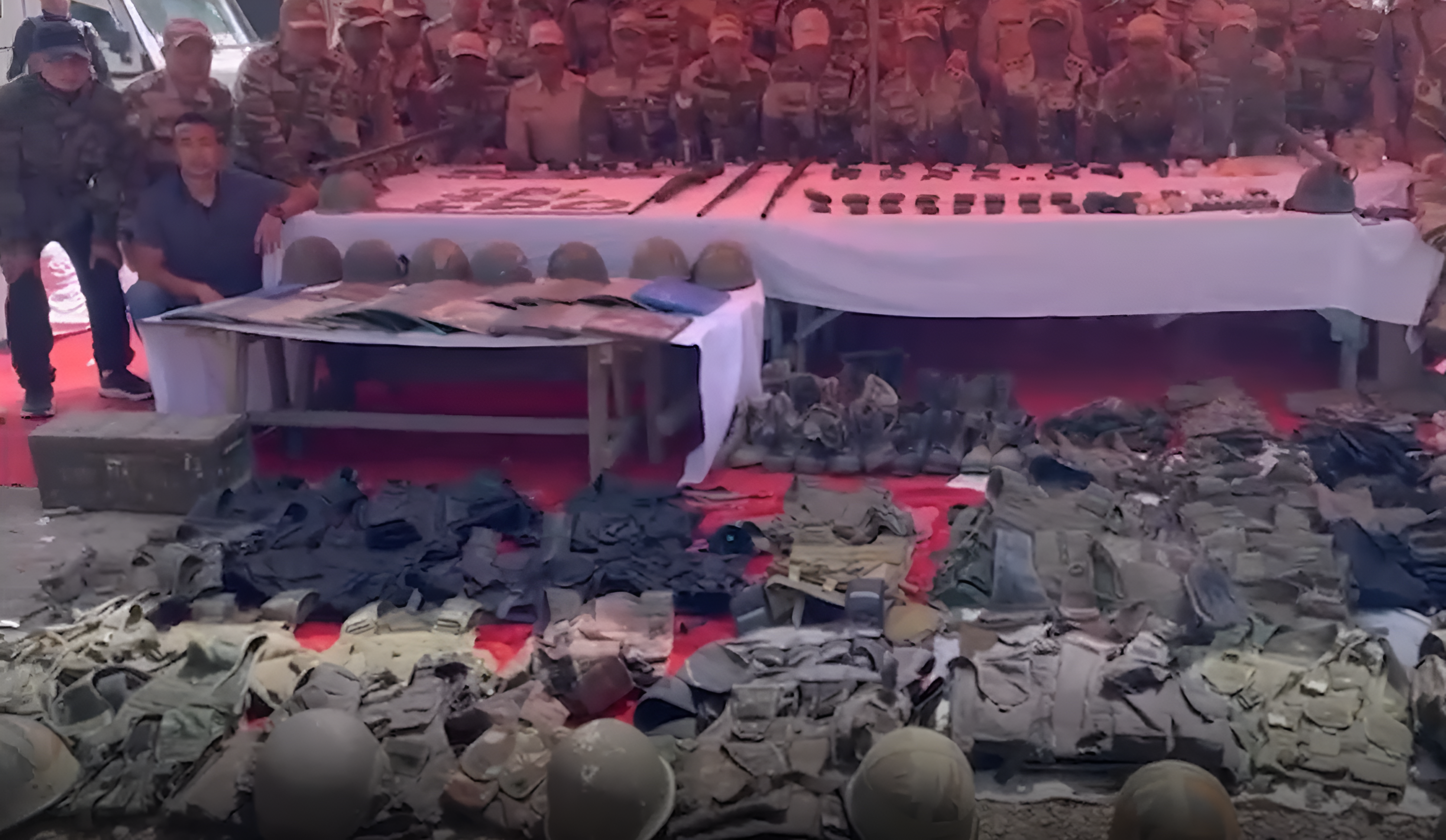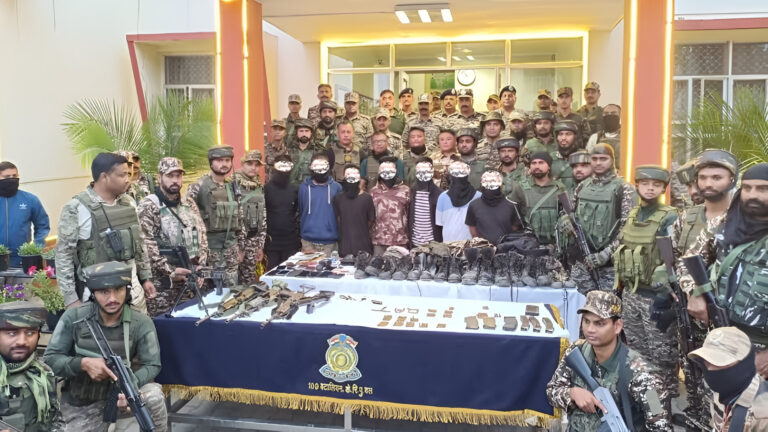Illegal Arms Surrendered in Manipur After Governor’s Appeal: A Milestone in the Fight Against Illicit Arms Trafficking
Introduction
Have you ever wondered what it takes to truly secure a region? Imagine the sense of relief that washes over a community when dangerous weapons are removed from circulation. That’s exactly what’s happening in Manipur, where a recent governor’s appeal spurred the surrender of illegal arms and led to the recovery of a major cache. This isn’t just another headline—it’s a story of determination, community cooperation, and a renewed commitment to public safety. In this article, we’re diving deep into the details of this remarkable development, discussing its background, the events that led to it, and its broader implications. So, let’s get into it and understand why this event is a turning point for Manipur.
Understanding the Context: The History of Illegal Arms in Manipur
Manipur, with its rich cultural heritage and strategic location, has long faced challenges related to illegal arms trafficking. Over the years, the influx of unauthorized weapons has not only posed serious security threats but also fueled regional instability. Illegal arms often find their way into the hands of insurgents and criminal elements, exacerbating conflicts and putting innocent lives at risk.
Historically, the region’s rugged terrain and porous borders have made it a hotspot for the smuggling and circulation of arms. The illicit trade thrives in environments where governance faces hurdles and law enforcement is stretched thin. This context sets the stage for understanding why every effort to curtail this trade is celebrated as a significant victory.
The Governor’s Appeal: A Call to Action
So, what prompted the recent surrender of these illegal arms? It all began with a heartfelt appeal from Manipur’s governor—a call that resonated with many and signaled a strong stance against the spread of dangerous weaponry. The governor’s message was clear: it’s time to put public safety first and take decisive action against those contributing to the arms trade.
Imagine a community leader standing at the forefront, urging people to step up and be part of a larger movement for peace and security. That’s exactly what happened. The governor’s appeal was more than just words; it was a clarion call for accountability and change. His message reached deep into the hearts of those involved in the arms trade, prompting many to reconsider their actions and choose to surrender their illegal weapons voluntarily.
This appeal was a pivotal moment—it not only demonstrated leadership but also fostered an environment where individuals felt encouraged to make a positive change. It’s like a spark that ignites a chain reaction, leading to collective action and, ultimately, safer communities.
The Surrender of Illegal Arms: A Closer Look at the Process
When we talk about the surrender of illegal arms, we’re discussing a process that involves risk, trust, and the willingness to embrace change. Here’s how it unfolded:
- Voluntary Surrender:
In response to the governor’s impassioned plea, several individuals associated with illegal arms began coming forward to surrender their weapons. This voluntary act is a testament to the power of leadership and the impact of a well-communicated message. It’s like watching a group of people decide to turn over a new leaf, choosing a path that contributes to the greater good. - Coordinated Efforts by Authorities:
Law enforcement agencies played a crucial role in facilitating a safe and organized surrender process. With dedicated teams on the ground, the authorities ensured that every surrendered weapon was accounted for and secured. This coordinated effort minimized chaos and reinforced the message that the government is committed to taking firm action against illegal arms trafficking. - Transparency and Trust:
One of the key reasons behind the success of this operation was the transparent process adopted by the authorities. When people see that the process is fair and that their actions will lead to tangible improvements in community safety, it builds trust. In this case, transparency acted like a bridge, connecting the intentions of the governor with the actions of the people.
This process not only removed dangerous weapons from circulation but also sent a powerful message: that cooperation between the public and the state can lead to monumental change.
The Major Cache Recovered: What’s Inside the Arsenal?
Recovering a major cache of illegal arms is no small feat. The cache, discovered as a direct outcome of the surrender process, includes a diverse range of weaponry that had the potential to cause significant harm. Let’s take a closer look at what was found and why it matters:
- Variety of Weapons:
The recovered cache included small arms, ammunition, and even components that could be assembled into more sophisticated weaponry. Each piece of this arsenal represents not just a physical threat but also the potential for escalating violence if left unchecked. - Implications for Security:
The recovery of such a cache is a massive win for law enforcement. It disrupts the supply chain of illegal arms and prevents these weapons from reaching hostile groups or being used in violent confrontations. Think of it as removing a ticking time bomb from a community—once neutralized, the threat level drops significantly. - Symbolic Victory:
Beyond the immediate security benefits, the recovery of the cache serves as a symbolic victory for the state. It’s a concrete demonstration that the government is not only talking the talk but also walking the walk. For the people of Manipur, it’s like a weight being lifted off their shoulders, knowing that dangerous arms are no longer lurking in the shadows.
The significance of this discovery cannot be overstated. Every weapon removed from the black market is a step toward a safer, more secure future for the entire region.
Impact on Public Safety and Community Well-Being
At its core, the surrender of illegal arms and the recovery of the cache are about one thing: ensuring the safety and well-being of the community. When dangerous weapons are removed from circulation, the positive ripple effects are felt far and wide.
- Enhanced Community Trust:
Actions like these build a sense of security among the local populace. When people see that their leaders and law enforcement agencies are working diligently to protect them, trust in public institutions grows. It’s like having a reliable safety net that reassures you during turbulent times. - Reduction in Violence:
With fewer weapons on the streets, the potential for violent confrontations diminishes. This directly contributes to a decrease in crime rates and fosters an environment where peaceful coexistence can flourish. Imagine living in a neighborhood where the threat of sudden violence is replaced by a calm and confident atmosphere. - Empowering the Community:
The voluntary surrender of arms sends a strong message about the power of collective action. It empowers ordinary citizens to be part of the solution rather than feeling helpless in the face of overwhelming challenges. In a way, it’s a community reclaiming its power and taking charge of its destiny.
These impacts are crucial for long-term stability. When communities feel safe and supported, they are more likely to invest in their future, be it through education, business, or community development projects.
Role of Law Enforcement: The Unsung Heroes
Let’s take a moment to appreciate the role of the local law enforcement agencies. Their tireless efforts behind the scenes are what made this operation successful. From intelligence gathering to ensuring a smooth surrender process, the police and security forces played a pivotal role.
- Strategic Planning and Execution:
The operation was marked by careful planning and precise execution. Law enforcement agencies worked in tandem with local authorities to ensure that every step was coordinated and that no detail was overlooked. This level of professionalism is essential when dealing with high-stakes situations like the surrender of illegal arms. - Building Community Relationships:
Trust between the police and the local community is paramount. By conducting the operation transparently and with respect for the citizens, law enforcement has strengthened its bond with the public. This relationship is like a solid foundation upon which future security measures can be built. - Preventing Future Threats:
Beyond the immediate recovery of the cache, the efforts of law enforcement have a lasting impact. By disrupting the networks that facilitate the illegal arms trade, these agencies are helping to pave the way for a future where such threats are minimized. Their ongoing vigilance is critical in ensuring that this success is not just a one-time event, but a turning point in the region’s security landscape.
Community Reactions: Voices from the Ground
No news is complete without hearing from the people it affects. The surrender of illegal arms has sparked a range of reactions from the local community, and these voices paint a picture of hope and cautious optimism.
- Relief and Gratitude:
Many residents expressed immense relief at the news, welcoming the removal of dangerous arms from their neighborhoods. For them, this is not just a win for law enforcement, but a win for every family that now feels a bit safer. It’s like finally closing the door on a long-standing source of anxiety. - Calls for Continued Vigilance:
While there is much to celebrate, some community members also urge for continued vigilance. They emphasize that while this operation is a significant step forward, maintaining long-term peace requires sustained effort and proactive measures. Their message is clear: keep the momentum going, and don’t let your guard down. - Hope for a Brighter Future:
Beyond immediate relief, the operation has instilled hope for lasting change. Community leaders believe that this initiative can serve as a catalyst for further positive developments, encouraging more people to come forward and support similar actions in the future. It’s like witnessing the first rays of a sunrise after a long, dark night.
These varied reactions highlight the importance of community engagement in any security operation. When citizens feel involved, every success resonates more deeply and contributes to a broader culture of trust and cooperation.
The Broader Implications: A Step Toward Sustainable Security
The recovery of illegal arms and the subsequent dismantling of a dangerous cache are not isolated events. They have broader implications that extend beyond immediate security concerns, setting the stage for long-term stability and growth.
- Disrupting Criminal Networks:
Each weapon surrendered is a blow to the criminal networks that thrive on illegal arms trafficking. This operation has disrupted the flow of dangerous weapons, weakening the financial and operational capabilities of these groups. Imagine a vast, intricate web being slowly dismantled—each removed strand brings the entire structure closer to collapse. - Strengthening the Rule of Law:
When illegal activities are met with decisive action, it reinforces the notion that the rule of law prevails. This not only deters future offenders but also reassures the public that justice is served consistently. It’s a message that resonates deeply in a community striving for peace and order. - Encouraging Community Cooperation:
The success of this operation sets a powerful precedent for future initiatives. When the community sees that cooperation with authorities yields tangible benefits, it creates an environment where proactive engagement becomes the norm. This spirit of collaboration is essential for tackling future challenges, whether they be related to security, development, or social welfare. - A Model for Other Regions:
The approach taken in Manipur could serve as an inspiring model for other regions grappling with similar issues. The blend of strong leadership, transparent processes, and community involvement is a formula that, if replicated, can lead to significant improvements in public safety across the country.
Future Prospects: What Lies Ahead?
While the recovery of illegal arms is a major achievement, it is only the beginning. The path ahead involves building on this success and ensuring that the momentum is sustained over the long term.
- Enhanced Monitoring and Surveillance:
To prevent the re-emergence of illegal arms trafficking, authorities are likely to ramp up their monitoring efforts. Advances in technology such as drones, real-time data analytics, and enhanced border surveillance will be key tools in this ongoing fight. It’s akin to installing a high-tech security system that keeps potential threats at bay. - Legislative and Policy Reforms:
Strengthening laws and policies around arms control can further reinforce these efforts. Lawmakers may consider stricter regulations and harsher penalties for those caught participating in the illegal arms trade. Such measures would act as a strong deterrent, sending a clear message that criminal activities will not be tolerated. - Community Outreach Programs:
Sustaining community trust is vital for long-term success. Authorities might launch more outreach programs to educate the public on the dangers of illegal arms and the benefits of cooperating with law enforcement. Empowering citizens with knowledge can transform them into active partners in maintaining public safety. - Continued Leadership and Accountability:
The role of visionary leaders, like Manipur’s governor, remains crucial. Their continued commitment to transparency, accountability, and proactive measures will drive further progress. When leaders stand firm and lead by example, it inspires confidence and encourages everyone to contribute to a safer environment.
Challenges and Opportunities: Balancing Security with Civil Liberties
Every major security initiative faces challenges, and the recovery of illegal arms in Manipur is no exception. While the benefits are clear, it’s important to acknowledge the potential hurdles and explore opportunities to overcome them.
- Resource Constraints:
Sustaining such operations requires considerable resources, both in terms of manpower and technology. Ensuring that law enforcement is well-equipped and supported financially is an ongoing challenge, but it also presents an opportunity for government and private partnerships. - Navigating Bureaucratic Hurdles:
Implementing strict measures without infringing on civil liberties requires a delicate balance. Authorities must navigate bureaucratic red tape while maintaining transparency and accountability—a process that demands constant evaluation and adaptation. - Community Skepticism:
Although many residents have welcomed the recent developments, skepticism can linger from past experiences. Continued efforts to engage with and listen to the community will be crucial in overcoming these concerns and building lasting trust. - Adapting to Evolving Threats:
The world of illicit arms trafficking is dynamic, with new threats emerging regularly. Staying ahead of these trends requires innovation, flexibility, and the constant updating of strategies. This challenge also opens the door to integrating cutting-edge technology and modern tactics into traditional law enforcement methods.
Conclusion
The surrender of illegal arms and the recovery of a major cache in Manipur represent a watershed moment in the ongoing fight against illicit arms trafficking. Sparked by the governor’s impassioned appeal and supported by robust law enforcement efforts, this initiative has not only removed dangerous weapons from circulation but also ignited hope and strengthened community bonds.
From disrupting criminal networks to enhancing public trust and paving the way for future security reforms, every aspect of this operation underscores the transformative power of collective action. It’s like witnessing a storm clear the sky—after the turbulence, a calm and secure future begins to emerge.
As Manipur looks ahead, the lessons learned from this operation will serve as a blueprint for continued progress. With the commitment of visionary leaders, the cooperation of the community, and the unyielding dedication of law enforcement, the region is poised to usher in a new era of safety and prosperity.
Every step taken today is a building block for a future where every citizen can live without fear, where communities flourish, and where the rule of law stands as a beacon of hope for all. Let this milestone remind us that, even in the face of daunting challenges, the power of unity and decisive action can light the way to a brighter tomorrow.
FAQs
- What triggered the surrender of illegal arms in Manipur?
The surrender was initiated following a heartfelt appeal by Manipur’s governor, which called for the voluntary handover of dangerous weapons, prompting many involved in the illegal arms trade to come forward. - What types of arms were recovered in the major cache?
The recovered cache included a variety of weapons such as small arms, ammunition, and components that could be assembled into more advanced weaponry, significantly reducing the threat of these arms being misused. - How did law enforcement ensure a safe and transparent surrender process?
Authorities coordinated closely with local agencies, using advanced monitoring and community outreach programs to create a transparent process that encouraged voluntary surrender while ensuring accountability and public safety. - What impact does the recovery of the arms cache have on public safety?
Removing these illegal weapons from circulation lowers the risk of violent confrontations and disrupts criminal networks, ultimately enhancing the overall security and well-being of the community. - What are the future steps planned to prevent the recurrence of illegal arms trafficking in the region?
Future measures include enhanced surveillance, stricter legislative reforms, continued community outreach, and the integration of modern technologies to ensure ongoing monitoring and swift action against any emerging threats.





